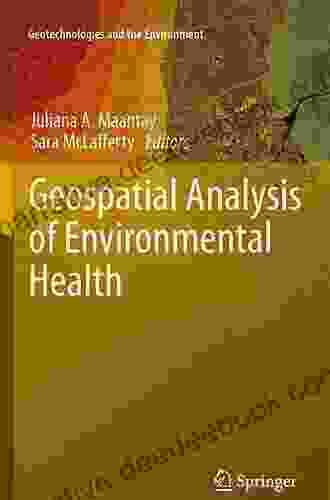Geospatial Analysis of Environmental Health Geotechnologies and the Environment

5 out of 5
| Language | : | English |
| Paperback | : | 352 pages |
| Item Weight | : | 13 ounces |
| Dimensions | : | 5.04 x 0.79 x 7.8 inches |
| File size | : | 20091 KB |
| Text-to-Speech | : | Enabled |
| Enhanced typesetting | : | Enabled |
| Word Wise | : | Enabled |
| Print length | : | 778 pages |
| Screen Reader | : | Supported |
Geospatial analysis is a powerful tool for understanding the relationship between the environment and human health. By overlaying data on environmental factors such as air pollution, water quality, and land use with data on health outcomes, researchers can identify areas where environmental hazards are posing a risk to human health. This information can then be used to develop policies and interventions to protect public health.
How Geospatial Analysis is Used in Environmental Health
Geospatial analysis is used in environmental health to identify and assess the risks posed by environmental hazards to human health. This information can then be used to develop policies and interventions to protect public health.
Some of the specific ways that geospatial analysis is used in environmental health include:
- Identifying areas with high levels of air pollution and linking them to health outcomes such as asthma, heart disease, and cancer.
- Assessing the risk of waterborne diseases by overlaying data on water quality with data on population density and sanitation.
- Identifying areas where land use changes are leading to increased exposure to environmental hazards, such as traffic-related air pollution or noise.
- Developing models to predict the spread of infectious diseases and identify areas where outbreaks are likely to occur.
- Evaluating the effectiveness of environmental health interventions, such as air pollution control programs or water filtration systems.
Benefits of Using Geospatial Analysis in Environmental Health
There are many benefits to using geospatial analysis in environmental health. These benefits include:
- Improved understanding of the relationship between the environment and human health. Geospatial analysis can help researchers to identify the environmental factors that are most strongly associated with health outcomes. This information can then be used to develop policies and interventions to protect public health.
- More effective environmental health interventions. Geospatial analysis can help to identify the areas where environmental health interventions are most needed. This information can then be used to target interventions to the areas where they will have the greatest impact.
- Improved decision making. Geospatial analysis can provide decision makers with the information they need to make informed decisions about environmental health policies and interventions.
Challenges to Using Geospatial Analysis in Environmental Health
There are also some challenges to using geospatial analysis in environmental health. These challenges include:
- Data availability and quality. The quality and availability of environmental health data can vary widely. This can make it difficult to conduct accurate and reliable geospatial analyses.
- Data integration. Integrating data from different sources can be a challenge. This is especially true when the data is collected at different scales or using different methods.
- Model development and validation. Developing and validating models to predict environmental health outcomes can be a complex and time-consuming process.
Geospatial analysis is a powerful tool for understanding the relationship between the environment and human health. This information can then be used to develop policies and interventions to protect public health. However, there are also some challenges to using geospatial analysis in environmental health. These challenges include data availability and quality, data integration, and model development and validation.
Despite these challenges, geospatial analysis is a valuable tool for environmental health researchers and practitioners. By using geospatial analysis, we can better understand the environmental factors that are posing a risk to human health and develop more effective interventions to protect public health.
5 out of 5
| Language | : | English |
| Paperback | : | 352 pages |
| Item Weight | : | 13 ounces |
| Dimensions | : | 5.04 x 0.79 x 7.8 inches |
| File size | : | 20091 KB |
| Text-to-Speech | : | Enabled |
| Enhanced typesetting | : | Enabled |
| Word Wise | : | Enabled |
| Print length | : | 778 pages |
| Screen Reader | : | Supported |
Do you want to contribute by writing guest posts on this blog?
Please contact us and send us a resume of previous articles that you have written.
 Page
Page Chapter
Chapter Story
Story Reader
Reader Library
Library Paperback
Paperback E-book
E-book Newspaper
Newspaper Bookmark
Bookmark Bibliography
Bibliography Foreword
Foreword Footnote
Footnote Codex
Codex Tome
Tome Bestseller
Bestseller Library card
Library card Biography
Biography Autobiography
Autobiography Reference
Reference Encyclopedia
Encyclopedia Dictionary
Dictionary Narrator
Narrator Character
Character Catalog
Catalog Card Catalog
Card Catalog Research
Research Scholarly
Scholarly Lending
Lending Reserve
Reserve Journals
Journals Reading Room
Reading Room Special Collections
Special Collections Interlibrary
Interlibrary Literacy
Literacy Study Group
Study Group Thesis
Thesis Dissertation
Dissertation Awards
Awards Reading List
Reading List Textbooks
Textbooks Ama Ata Aidoo
Ama Ata Aidoo Andrew J Pankratz
Andrew J Pankratz Young H D Kim
Young H D Kim Katherine Hupp
Katherine Hupp Nicholas Rzhevsky
Nicholas Rzhevsky Terry Gamble
Terry Gamble Leslie Fram
Leslie Fram Joni Mccoy
Joni Mccoy Thomas A Stewart
Thomas A Stewart Albert Kostenevitch
Albert Kostenevitch Pablo E Cisneros
Pablo E Cisneros Peter E Quint
Peter E Quint Amy M Le
Amy M Le Sarah C Campbell
Sarah C Campbell Raajesh Sr
Raajesh Sr Erin Swann
Erin Swann Martin Lund
Martin Lund Vampyre Lunakaray
Vampyre Lunakaray Genevieve Miller
Genevieve Miller Joseph O Chapa
Joseph O Chapa
Light bulbAdvertise smarter! Our strategic ad space ensures maximum exposure. Reserve your spot today!
 Nathaniel HawthorneFollow ·10.9k
Nathaniel HawthorneFollow ·10.9k Fredrick CoxFollow ·15.4k
Fredrick CoxFollow ·15.4k Gabriel HayesFollow ·17.2k
Gabriel HayesFollow ·17.2k Oscar BellFollow ·2.6k
Oscar BellFollow ·2.6k Kevin TurnerFollow ·12.5k
Kevin TurnerFollow ·12.5k Samuel WardFollow ·2.6k
Samuel WardFollow ·2.6k Langston HughesFollow ·13.5k
Langston HughesFollow ·13.5k Edward BellFollow ·10.1k
Edward BellFollow ·10.1k

 Dallas Turner
Dallas TurnerParasols and Peril: Adventures in Grace
In the quaint town...

 Caleb Carter
Caleb CarterFlight Attendant Joe: A Dedicated Professional in the...
Flight Attendant Joe...

 Jerry Ward
Jerry WardPick Lottery The List For 23 States August 15 2024
The Pick Lottery is a multi-state lottery...

 Hudson Hayes
Hudson HayesHow the Media Wields Dangerous Words to Divide a Nation
In a world where the media is...

 Curtis Stewart
Curtis StewartThe Magic Mala: A Story That Changes Lives
In the realm of ancient traditions and...

 Raymond Parker
Raymond ParkerEarthly Meditations: A Poetic Tapestry of Nature,...
In the realm of contemporary...
5 out of 5
| Language | : | English |
| Paperback | : | 352 pages |
| Item Weight | : | 13 ounces |
| Dimensions | : | 5.04 x 0.79 x 7.8 inches |
| File size | : | 20091 KB |
| Text-to-Speech | : | Enabled |
| Enhanced typesetting | : | Enabled |
| Word Wise | : | Enabled |
| Print length | : | 778 pages |
| Screen Reader | : | Supported |












